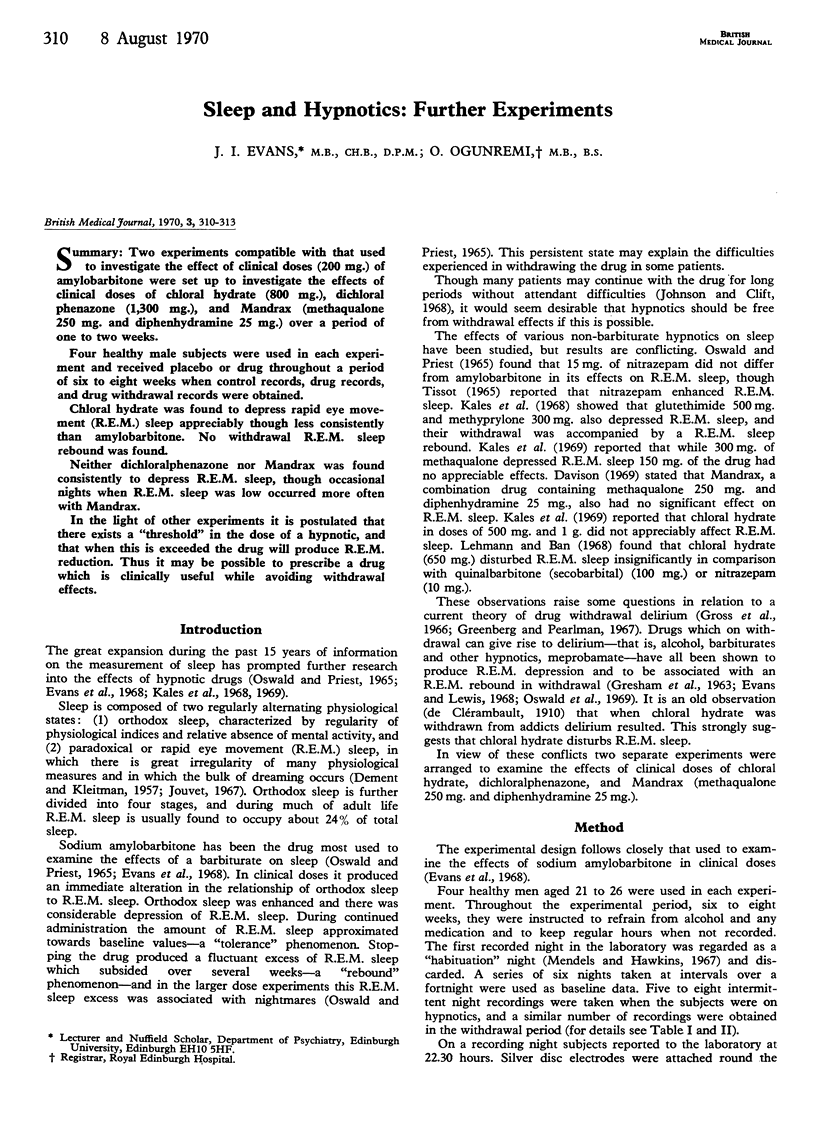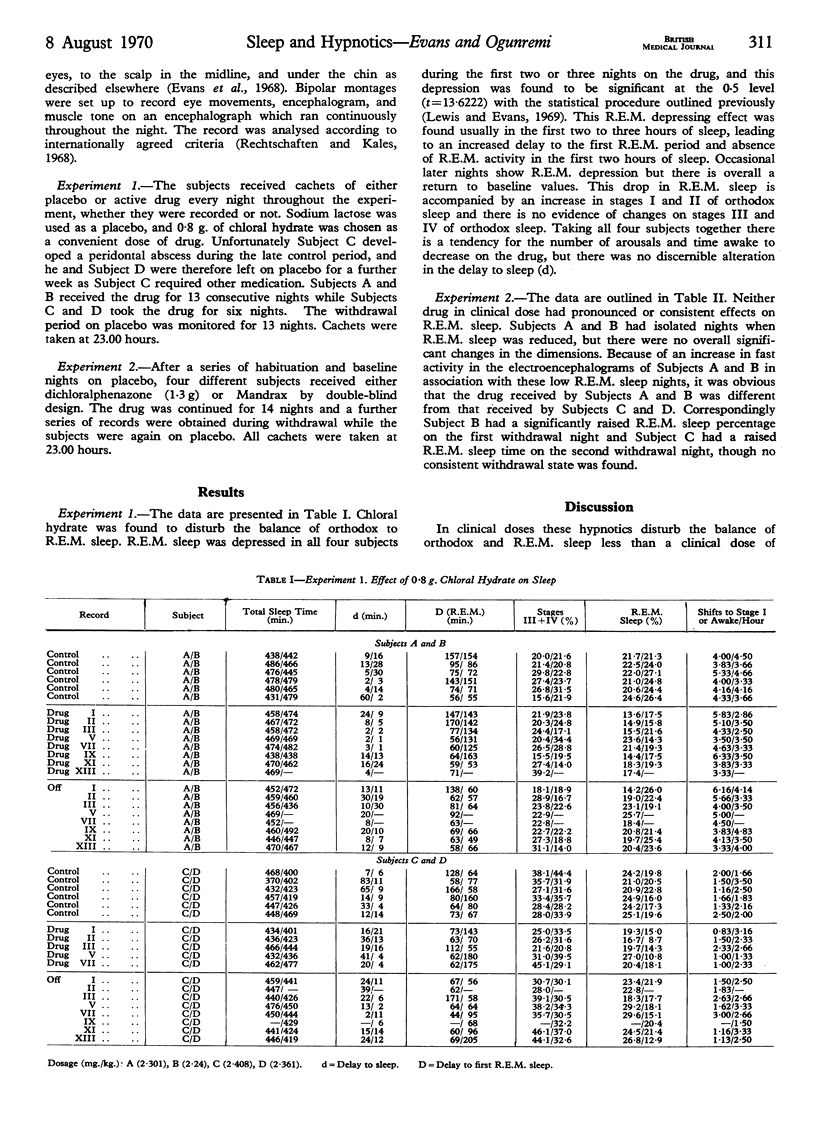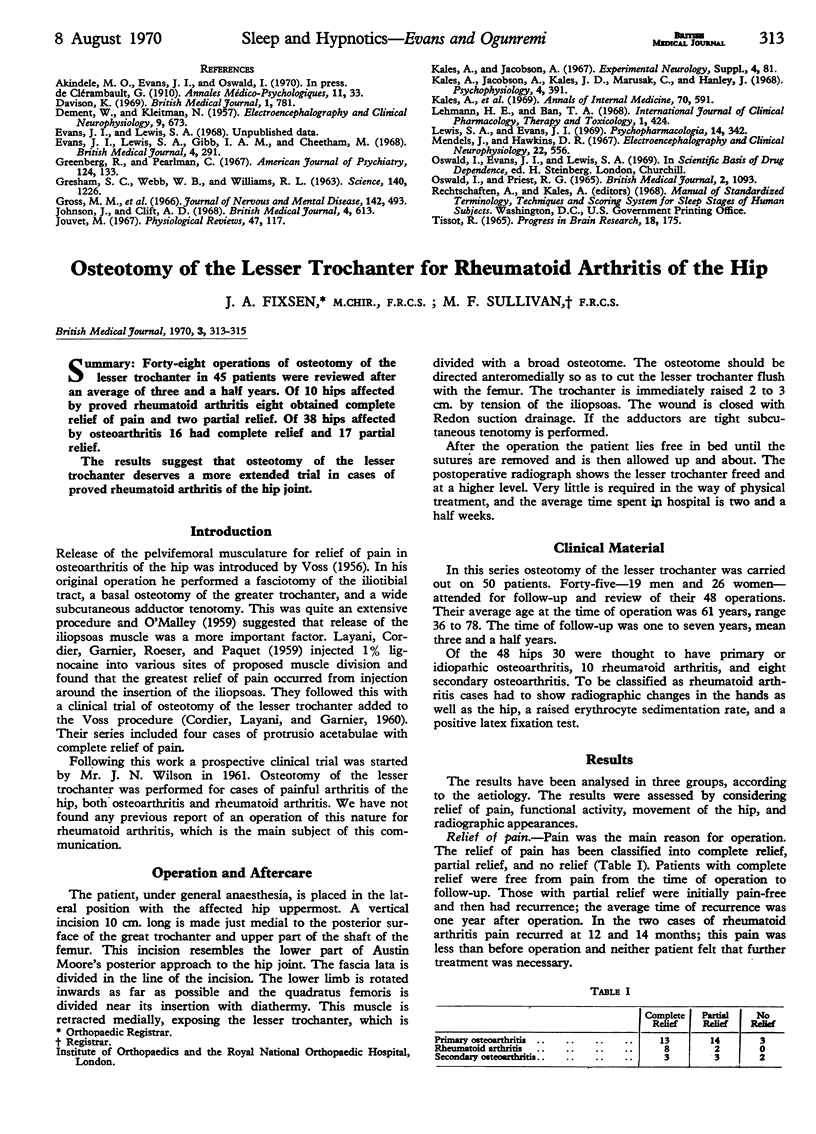Abstract
Two experiments compatible with that used to investigate the effect of clinical doses (200 mg.) of amylobarbitone were set up to investigate the effects of clinical doses of chloral hydrate (800 mg.), dichloral phenazone (1,300 mg.), and Mandrax (methaqualone 250 mg. and diphenhydramine 25 mg.) over a period of one to two weeks.
Four healthy male subjects were used in each experiment and received placebo or drug throughout a period of six to eight weeks when control records, drug records, and drug withdrawal records were obtained.
Chloral hydrate was found to depress rapid eye movement (R.E.M.) sleep appreciably though less consistently than amylobarbitone. No withdrawal R.E.M. sleep rebound was found.
Neither dichloralphenazone nor Mandrax was found consistently to depress R.E.M. sleep, though occasional nights when R.E.M. sleep was low occurred more often with Mandrax.
In the light of other experiments it is postulated that there exists a “threshold” in the dose of a hypnotic, and that when this is exceeded the drug will produce R.E.M. reduction. Thus it may be possible to prescribe a drug which is clinically useful while avoiding withdrawal effects.
Full text
PDF



Selected References
These references are in PubMed. This may not be the complete list of references from this article.
- DEMENT W., KLEITMAN N. Cyclic variations in EEG during sleep and their relation to eye movements, body motility, and dreaming. Electroencephalogr Clin Neurophysiol. 1957 Nov;9(4):673–690. doi: 10.1016/0013-4694(57)90088-3. [DOI] [PubMed] [Google Scholar]
- Evans J. I., Lewis S. A., Gibb I. A., Cheetham M. Sleep and birbiturates: some experiments and observations. Br Med J. 1968 Nov 2;4(5626):291–293. doi: 10.1136/bmj.4.5626.291. [DOI] [PMC free article] [PubMed] [Google Scholar]
- GRESHAM S. C., WEBB W. B., WILLIAMS R. L. Alcohol and caffeine: effect on inferred visual dreaming. Science. 1963 Jun 14;140(3572):1226–1227. doi: 10.1126/science.140.3572.1226. [DOI] [PubMed] [Google Scholar]
- Greenberg R., Pearlman C. Delirium tremens and dreaming. Am J Psychiatry. 1967 Aug;124(2):133–142. doi: 10.1176/ajp.124.2.133. [DOI] [PubMed] [Google Scholar]
- Gross M. M., Goodenough D., Tobin M., Halpert E., Lepore D., Perlstein A., Sirota M., Dibianco J., Fuller R., Kishner I. Sleep disturbances and hallucinations in the acute alcoholic psychoses. J Nerv Ment Dis. 1966 Jun;142(6):493–514. doi: 10.1097/00005053-196606000-00001. [DOI] [PubMed] [Google Scholar]
- Johnson J., Clift A. D. Dependence on hypnotic drugs in general practice. Br Med J. 1968 Dec 7;4(5631):613–617. doi: 10.1136/bmj.4.5631.613. [DOI] [PMC free article] [PubMed] [Google Scholar]
- Jouvet M. Neurophysiology of the states of sleep. Physiol Rev. 1967 Apr;47(2):117–177. doi: 10.1152/physrev.1967.47.2.117. [DOI] [PubMed] [Google Scholar]
- Kales A., Heuser G., Kales J. D., Rickles W. H., Jr, Rubin R. T., Scharf M. B., Ungerleider J. T., Winters W. D. Drug dependency. Investigations of stimulants and depressants. Ann Intern Med. 1969 Mar;70(3):591–614. doi: 10.7326/0003-4819-70-3-591. [DOI] [PubMed] [Google Scholar]
- Lehmann H. E., Ban T. A. The effect of hypnotics on rapid eye movement (REM). Int Z Klin Pharmakol Ther Toxikol. 1968 Jul;1(5):424–427. [PubMed] [Google Scholar]
- Lewis S. A., Evans J. I. Dose effects of chlorpromazine on human sleep. Psychopharmacologia. 1969;14(4):342–348. doi: 10.1007/BF02190118. [DOI] [PubMed] [Google Scholar]
- Mendels J., Hawkins D. R. Sleep laboratory adaptation in normal subjects and depressed patients ("first night effect"). Electroencephalogr Clin Neurophysiol. 1967 Jun;22(6):556–558. doi: 10.1016/0013-4694(67)90063-6. [DOI] [PubMed] [Google Scholar]
- Oswald I., Priest R. G. Five Weeks to Escape the Sleeping-pill Habit. Br Med J. 1965 Nov 6;2(5470):1093–1095. doi: 10.1136/bmj.2.5470.1093. [DOI] [PMC free article] [PubMed] [Google Scholar]
- TISSOT R. THE EFFECTS OF CERTAIN DRUGS ON THE SLEEP CYCLE IN MAN. Prog Brain Res. 1965;18:175–177. doi: 10.1016/s0079-6123(08)63593-1. [DOI] [PubMed] [Google Scholar]


